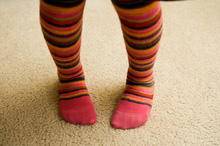Is Your Carpet a Hazardous Bio-Science Experiment Gone Wrong?
Why it's Time to Spring Clean Your Carpets!
by www.SixWise.com
More than two-thirds of American floors are covered by soft, cozy wall-to-wall carpeting, according to the Carpet and Rug Institute (CRI) -- carpeting that’s tromped on, played on and spilled on nearly every day.
|

Dirt and dust lurking in your home’s carpeting could become a health nuisance if not cleaned regularly.
|
Especially now as spring is here, and your carpet has accumulated a winter’s worth of dirt and grime, it’s the ideal time to give your carpeting a thorough cleaning. And while this will undoubtedly improve the way your carpet looks, it’s not only about aesthetics.
Why Keeping Your Carpet Clean is so Important
Think of your carpet as a giant sponge. Every day when you walk in the door, dirt and soil from your feet are absorbed, as is dust and any other substance in your home’s air. Carpets can and do accumulate toxins (such as cigarette smoke, pesticide sprays, paint fumes, etc.) and can slowly release them over time. Further, carpets with PVC backing may contain plasticizers that can react with moisture or humidity, resulting in an odor.
Your home’s carpet is also a very effective storage place for dust. Aside from dust mites that can exacerbate allergies and asthma, "house dust is a reservoir for many environmental toxins, “ according to a compilation of three studies reported by the Environmental Working Group. The studies found concentrations of the following chemicals in house dust, and if they’re in your dust, they’re in your carpeting as well:
Fire Retardants
- TBBPA, tetrabromobisphenol A
- HBCD, hexabromocyclododecane
- Tris breakdown product, 2,3-dibromo-1-propanol
Plastics Additives
- bisphenol A
- dibutyltin
- dioctyltin
- monobutyltin
- monooctyltin
- tributyltin
PVC Plastic, Personal Care Product Additives
- benzyl butyl phthalate
- bis(2-ethylhexyl) adipate
- bis(2-ethylhexyl) phthalate
- diethyl phthalate
- di-N-butyl phthalate
Pesticides
- bendiocarb
- carbaryl
- chlorpyrifos
- diedrin
- DDT
- methoxychlor
- pentachlorophenol
- piperonyl butoxide
- trans-permethrin
Food and Cosmetics Preservative
Industrial Detergent, Chemicals in Personal Care Products
- 4-nonylphenol
- nonylphenol diethoxylate
- nonylphenol monoethoxylate
The problem is that when you walk on carpet all of these chemicals get stirred up into the air where you can breathe them in, or settle on your skin where they can be absorbed. Plus, if you have toddlers who spend time crawling or playing on your carpeting, they could get these toxins on their hands and then transfer them into their mouth.
Children who crawl and put their fingers in their mouth can ingest 10 grams of dust per day. And, since they're smaller than adults and their systems are still developing, they are at a higher risk from contaminants.
How to Best Keep Your Carpeting Clean
There are three basic steps to keep your carpeting in tip-top condition, according to CRI.
1. Vacuum regularly: This helps remove loose debris while it’s on the surface, preventing it from being ground into the carpet pile. It also helps preserve the cushiness of your carpet. A general guideline:
- Vacuum daily in high-traffic or pet areas.
- Vacuum twice weekly in medium-traffic areas.
- Vacuum weekly in light-traffic areas, using attachments at carpet edges.
|
Enviro-Rite Carpet & Upholstery Cleaner: A Clean Home, Not a Toxic One

Using all-natural cleaning products is essential to keeping toxic vapors out of your home. Intended for use on both carpet and upholstery, Enviro-Rite Carpet Cleaner is an excellent vegetable-based cleaning concentrate that replaces all petroleum-based formulations used in hot water, extractor-type cleaning equipment.
This truly unique cleaner is specially developed by and for people with allergies, asthma and chemical sensitivities. EnviroRite Carpet Cleaner is:
- FREE of common respiratory and skin irritants.
- Made with naturally occurring renewable resources, containing no petrochemicals or added dyes or fragrances.
- Safe for use in closed environments and does not compromise indoor air quality.
- Free rinsing, leaving behind no irritating residue.
- A low-foaming formulation that is not high in caustic pH. Diluted correctly, the pH is 7.5.
- An environmentally responsible product.
- Never tested on animals.
|
2. Clean spills as soon as they happen. The longer you wait, the higher the chances the stain will become permanent, so act quickly. First blot the liquid with a plain white cloth or paper towel, then treat it with a non-toxic carpet cleaner. Like other cleaning agents, typical carpet cleaners contain known cancer-causing agents and many other harsh components linked with various ailments and disorders. This is why we highly recommend EnviroRite Carpet Cleaner, which is an excellent vegetable-based cleaning concentrate made with naturally occurring renewable resources, and containing no petrochemicals or added dyes or fragrances.
This truly unique cleaner is specially developed by and for people with allergies, asthma and chemical sensitivities, as it is completely safe and non-toxic.
And for tough stains, EnviroRite has an extremely effective non-toxic Spot Lifter. With EnviroRite Spot Lift even the toughest set-in mystery stains can vanish from your carpet and upholstery with no worries of harsh chemicals harming your family, your pets, or your carpet!
The entire EnviroRite line of non-toxic cleaning products contains no hazardous ingredients, petrochemicals, perfumes, dyes or animal by-products. These fume-free, vegetable-based cleaners and detergents make easy work of tough jobs.
You can also try the following all-natural home remedies to remove spills and stains from your carpet:
- Plain water (which often works better than untested carpet cleaners do, according to CRI.)
- A detergent solution of 1/4 teaspoon clear dishwashing liquid and one cup of warm water.
- A white vinegar solution made with one cup white vinegar and one cup of water.
- A general formula to remove all kinds of odors from carpeting is 1/2 cup of baking soda, 1/2 cup of corn starch and several drops of essential oil (for fragrance). Sprinkle the mixture on your carpet, let it sit overnight, then vacuum it up the next day.
3. Have your carpet deep cleaned every 12-18 months to clean out embedded dirt. Look for a carpet cleaning company that uses only non-toxic cleaners.
Further, you can drastically cut back on the dirt that gets on your carpet in the first place by using doormats at your entryways, in heavily trafficked areas and in front of frequently used furniture.
Be sure to choose high-quality mats and rugs that trap contaminants rather than adding to the problem like the Waterhog Grand Premier Mats and Rugs.
The Waterhog Grand Premier are no ordinary mats; in fact, they actually trap soil and liquids in the mat so they don't drain or track onto your carpets. That's why, odd as it may sound, the proper doormats and mats placed throughout your home that truly capture dirt and prevent it from becoming dust in your house is one of today's most essential health tools! To learn more, read The Most Unknown, Underrated but Crucial Health Tool.
Recommended Reading
The Toxic Dangers of Carpeting:Are the Carpets in Your Home or Office a Health Hazard?
How to Get Rid of Five Bad Smells Including Cat Urine, Dog Urine and More
Sources
The Carpet and Rug Institute